iRobot Bundle
Who Buys iRobot? Unveiling the Customer Behind the Roomba.
The failed Amazon acquisition of iRobot highlighted the crucial importance of understanding its customer base. This strategic move, had it succeeded, would have integrated iRobot's established customer base into a wider smart home ecosystem, showcasing the value of its customer demographics. Founded in 1990, iRobot transitioned from specialized robots to a household name with the launch of the Roomba, necessitating a shift in its market focus.
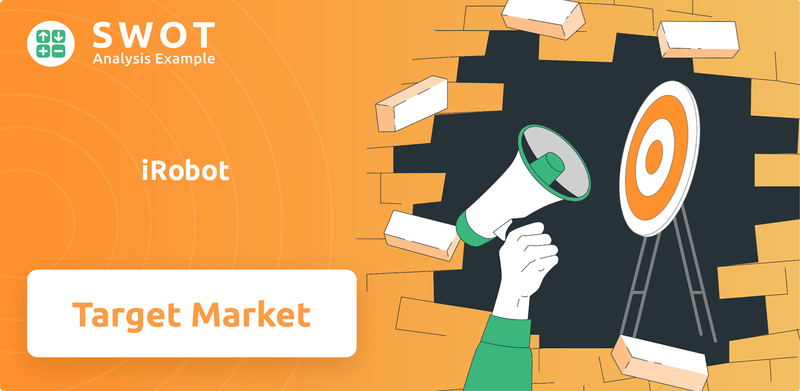
This shift required a deep dive into iRobot's iRobot SWOT Analysis, understanding consumer behavior, and performing thorough iRobot market analysis. Today, understanding the iRobot target market involves analyzing who buys iRobot Roomba, their age range, income level, and location data. This includes a granular look at iRobot user profile, and iRobot consumer demographics by product to effectively serve this diverse consumer market and understand iRobot customer purchase behavior analysis.
Who Are iRobot’s Main Customers?
Understanding the iRobot customer demographics and target market is key to grasping the company's success. Primarily, iRobot focuses on the business-to-consumer (B2C) market. Their primary customer base consists of middle-to-upper-income households who value convenience and smart home technology.
The iRobot target market includes busy professionals and families, often aged between 30 and 60. These consumers typically have disposable income to invest in products that automate household chores. Education levels tend to be higher, reflecting an interest in technology and innovation. This iRobot user profile helps the company tailor its offerings effectively.
iRobot's market segmentation has evolved over time. They have expanded their reach to include a broader range of income levels through various product tiers. This strategy allows them to capture a larger share of the household appliance market. For instance, the global robotic vacuum cleaner market was valued at approximately $4.3 billion in 2023, with continued growth expected, indicating a widening consumer base. The iRobot customer demographics include both individuals and families, with a growing emphasis on integrated smart home ecosystems.
While specific age data isn't always disclosed, the core demographic often falls between 30-60 years old. This range aligns with the target market of busy professionals and families. These individuals are more likely to have the financial resources and the need for time-saving devices.
iRobot primarily targets middle-to-upper-income households. This demographic can afford the initial investment in robotic vacuum cleaners and other smart home devices. The price point of iRobot products reflects this focus on a financially capable customer base.
iRobot products are sold globally, with a strong presence in North America and Europe. These regions have high adoption rates of smart home technology. The company also focuses on expanding its reach in emerging markets.
The Roomba line primarily targets busy individuals and families seeking convenience. They want to automate household chores. The target audience values time-saving solutions and is willing to invest in technology that simplifies their lives.
iRobot conducts continuous market research to understand consumer behavior. This helps them refine their product offerings and marketing strategies. The company analyzes iRobot consumer demographics by product to tailor their approach.
- iRobot uses data to understand who buys Roomba and other products.
- They analyze iRobot customer purchase behavior analysis.
- iRobot also examines the iRobot product adoption rate by demographic.
- The company uses this data to inform iRobot customer segmentation strategies.
iRobot SWOT Analysis
- Complete SWOT Breakdown
- Fully Customizable
- Editable in Excel & Word
- Professional Formatting
- Investor-Ready Format
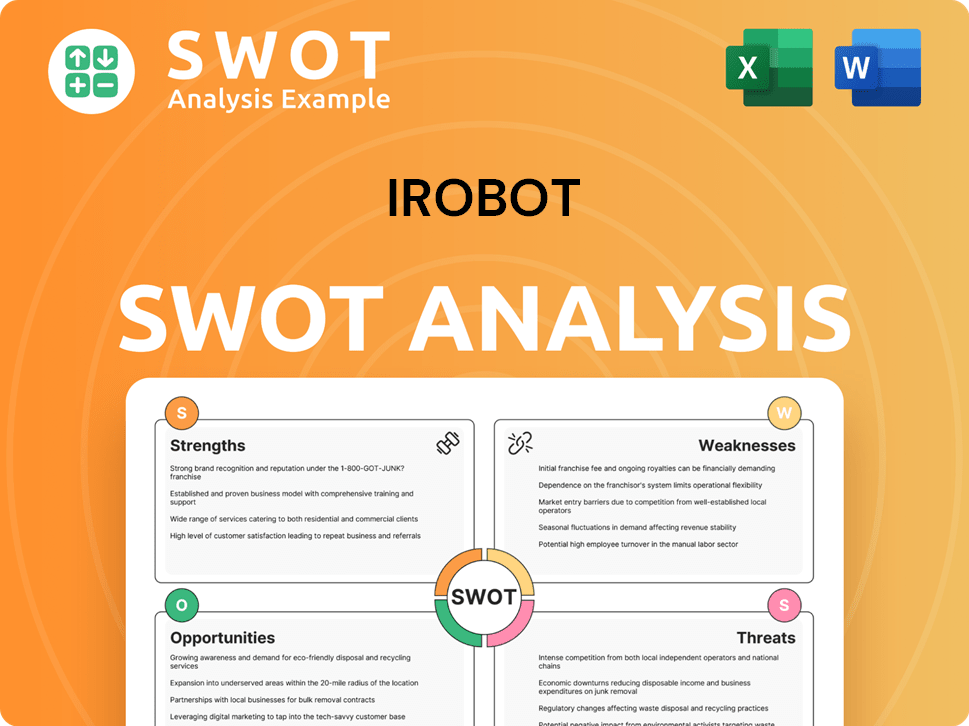
What Do iRobot’s Customers Want?
Understanding the customer needs and preferences is crucial for the success of any business. For the company, this involves a deep dive into what drives their customers to purchase and how they use their products. This analysis provides insights into the factors that influence consumer decisions and how the company can tailor its offerings to meet those needs effectively.
The primary drivers for customers are convenience, time-saving solutions, and a desire for a cleaner home with minimal effort. This is evident in their purchasing behaviors, which often include researching product reviews, comparing features, and considering integration with existing smart home systems. The company's success hinges on its ability to address these needs and preferences effectively.
The company's customers are driven by the need for convenience and time-saving solutions. They seek a cleaner home with minimal effort, influencing their purchasing decisions. The decision-making criteria revolve around performance, reliability, and ease of use.
The customer's needs and preferences are central to the company's product development and marketing strategies. The company focuses on providing solutions that align with these needs. The company's marketing highlights how its robots offer a clean home without significant user intervention.
- Convenience and Time-Saving: Customers prioritize solutions that save time and effort in household chores.
- Performance and Reliability: High-performance and reliable products are essential for customer satisfaction.
- Ease of Use: User-friendly products with simple operation and maintenance are preferred.
- Integration with Smart Home Systems: Compatibility with existing smart home ecosystems, like voice assistants, is a key feature.
- Advanced Features: Features like self-emptying dustbins and improved navigation systems meet customer expectations.
iRobot PESTLE Analysis
- Covers All 6 PESTLE Categories
- No Research Needed – Save Hours of Work
- Built by Experts, Trusted by Consultants
- Instant Download, Ready to Use
- 100% Editable, Fully Customizable
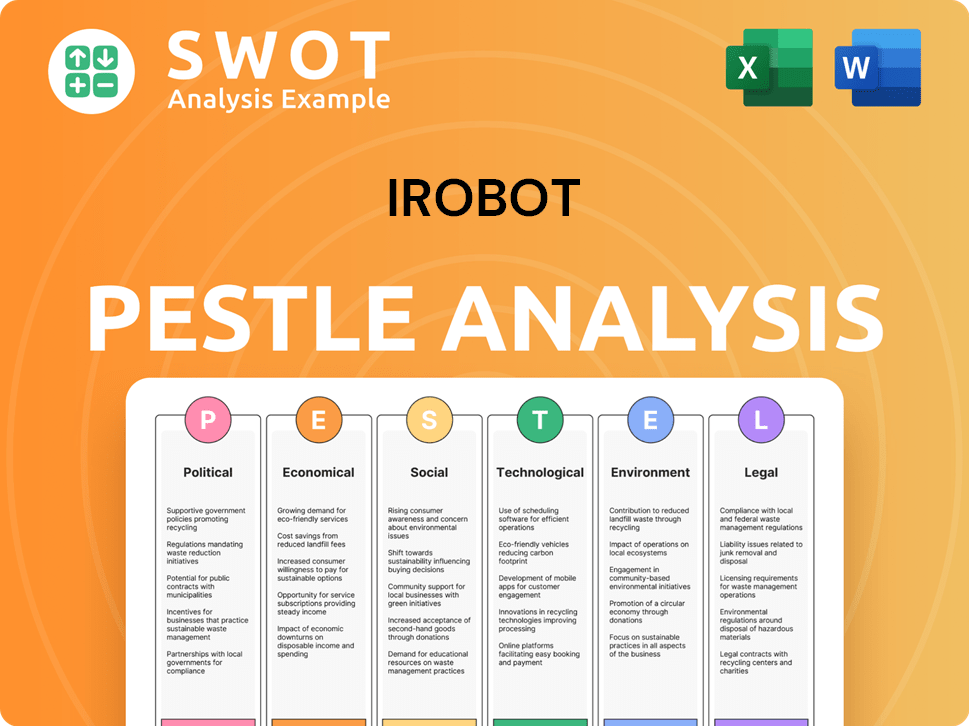
Where does iRobot operate?
The company maintains a substantial global presence, with its primary markets spanning North America, Europe, and Asia. The United States is a core market, where the company holds strong brand recognition. Europe, including countries like Germany, the UK, and France, also represents a significant market due to the high adoption of smart home devices. Asia, particularly Japan and China, is a growing market, although it presents unique consumer preferences and competitive landscapes.
The company's approach involves adapting product features, marketing messages, and pricing strategies to suit regional nuances. This includes developing region-specific marketing campaigns that resonate with local cultural values and partnering with local retailers and distributors to enhance market penetration. Recent expansions have focused on emerging markets in Southeast Asia and Latin America, indicating a strategy to diversify its global sales footprint. The company's annual reports often detail the geographic distribution of sales, showcasing the relative importance of these key regions to its overall revenue.
Understanding the Marketing Strategy of iRobot involves recognizing the diverse market segments it targets globally. Differences in customer demographics, preferences, and buying power are evident across these regions. For instance, while North American consumers might prioritize powerful suction and large dustbins, Asian consumers might place a higher value on compact designs and quiet operation due to smaller living spaces. This necessitates a flexible approach to product development and marketing.
North America is a key market for the company, with a significant portion of its sales originating from the United States. The iRobot user profile in this region typically includes households with a higher disposable income, often dual-income families, and individuals or couples who value convenience and time-saving solutions. The age range of iRobot customers in North America is broad, encompassing millennials to older generations, with a common interest in adopting smart home technologies.
Europe is a significant market, with key countries like Germany, the UK, and France showing high adoption rates of smart home devices. iRobot's consumer behavior in Europe is influenced by factors such as environmental awareness and a preference for technologically advanced products. The income level of iRobot buyers in Europe is generally in line with the average household income of each country, with a growing trend of middle-class families investing in automated cleaning solutions.
Asia, particularly Japan and China, represents a growing market, though it comes with distinct consumer preferences and competitive landscapes. The iRobot target market in Asia often includes urban dwellers living in smaller spaces, who value compact designs and quiet operation. iRobot's market segmentation in Asia involves adapting its products to meet local needs, such as developing models with features suitable for smaller apartments common in densely populated cities.
The company's product market share varies by region, with strong positions in North America and Europe. Recent expansions have focused on emerging markets in Southeast Asia and Latin America to diversify its global sales footprint. iRobot customer location data reveals a strategic focus on urban areas and regions with high internet penetration, reflecting its focus on tech-savvy consumers. The company's ability to adapt its products and marketing to local preferences is crucial for maintaining and growing its global market share.
iRobot Business Model Canvas
- Complete 9-Block Business Model Canvas
- Effortlessly Communicate Your Business Strategy
- Investor-Ready BMC Format
- 100% Editable and Customizable
- Clear and Structured Layout
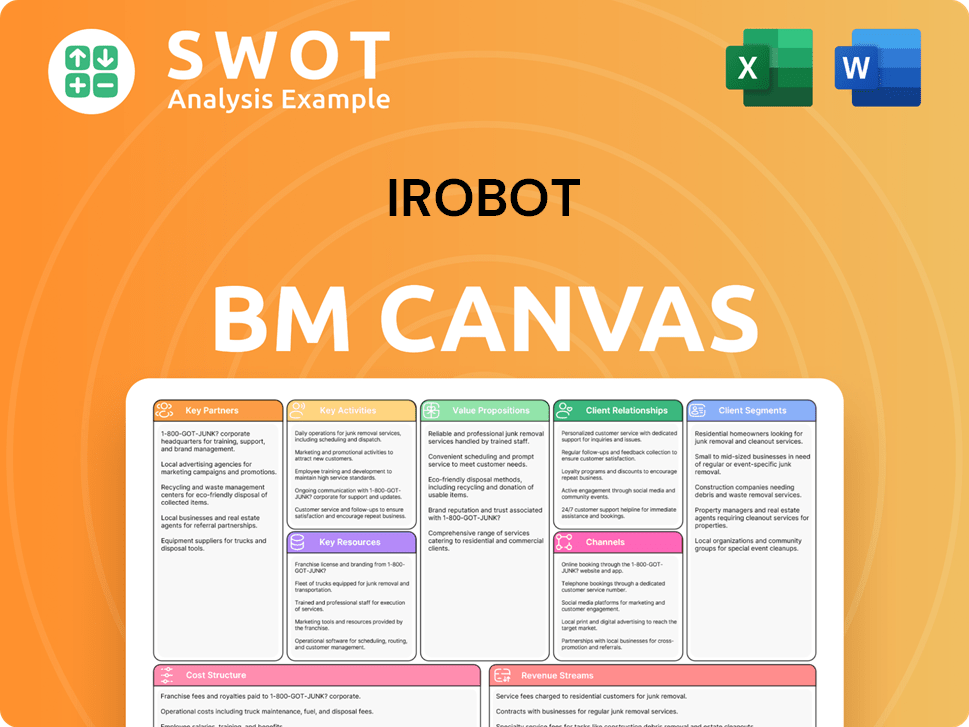
How Does iRobot Win & Keep Customers?
The company employs a multi-faceted strategy for acquiring and retaining customers, utilizing various marketing channels and customer engagement tactics. Digital marketing, including search engine optimization (SEO), pay-per-click (PPC) advertising, and social media campaigns on platforms like Facebook, Instagram, and YouTube, is crucial for reaching potential customers. Traditional advertising, such as television commercials and print media, is also used to build brand awareness. This approach helps to build a strong iRobot user profile by showcasing the products' benefits and building trust with potential customers.
Sales tactics include direct-to-consumer sales through its website, partnerships with major retailers like Amazon, Best Buy, and Target, and promotional offers during key shopping seasons. Customer data and CRM systems are vital for segmenting customers and tailoring marketing messages. For instance, the company might use purchase history to recommend complementary products or offer personalized discounts. Loyalty programs, such as exclusive access to new products or extended warranties, aim to foster repeat purchases and brand advocacy.
After-sales service, including responsive customer support, readily available spare parts, and easy-to-understand troubleshooting guides, is critical for customer satisfaction and retention. The company has continually refined its strategies, moving towards more personalized marketing and enhanced post-purchase support to improve customer lifetime value and reduce churn rates, especially in a competitive market where new robotic vacuum brands are constantly emerging. Analyzing the Competitors Landscape of iRobot is also critical to understanding the competitive dynamics in the market.
Digital marketing is a cornerstone of the company's customer acquisition strategy. SEO, PPC, and social media campaigns are used to reach potential customers. These efforts are designed to target the iRobot target market effectively.
Television commercials and print media are also utilized to build brand awareness. This helps to reach a broader audience and reinforce the brand message. This approach is part of the iRobot market analysis.
Collaborations with home organization and tech review channels showcase product benefits and build trust. This strategy is particularly effective in reaching the iRobot customer demographics. This is part of the iRobot market research report.
Referral programs incentivize existing customers to advocate for the company's products. This helps in acquiring new customers through trusted recommendations. This is a key element of iRobot's customer segmentation strategies.
Sales through its website provide a direct channel to customers. This allows for better control over the customer experience and direct engagement with the iRobot Roomba target audience.
Partnerships with major retailers like Amazon, Best Buy, and Target expand the company's reach. These collaborations make products accessible to a wider consumer base and influence iRobot consumer behavior.
Promotional offers during key shopping seasons drive sales and attract new customers. These offers are timed to capitalize on peak consumer spending periods and target the age range of iRobot customers.
Customer data and CRM systems are used to segment customers and tailor marketing messages. This enables personalized marketing and enhances iRobot customer purchase behavior analysis.
Loyalty programs, such as exclusive access to new products or extended warranties, foster repeat purchases. This strategy aims to increase the iRobot product adoption rate by demographic.
Responsive customer support, readily available spare parts, and easy-to-understand troubleshooting guides are critical. This boosts customer satisfaction and contributes to the iRobot ideal customer profile.
iRobot Porter's Five Forces Analysis
- Covers All 5 Competitive Forces in Detail
- Structured for Consultants, Students, and Founders
- 100% Editable in Microsoft Word & Excel
- Instant Digital Download – Use Immediately
- Compatible with Mac & PC – Fully Unlocked
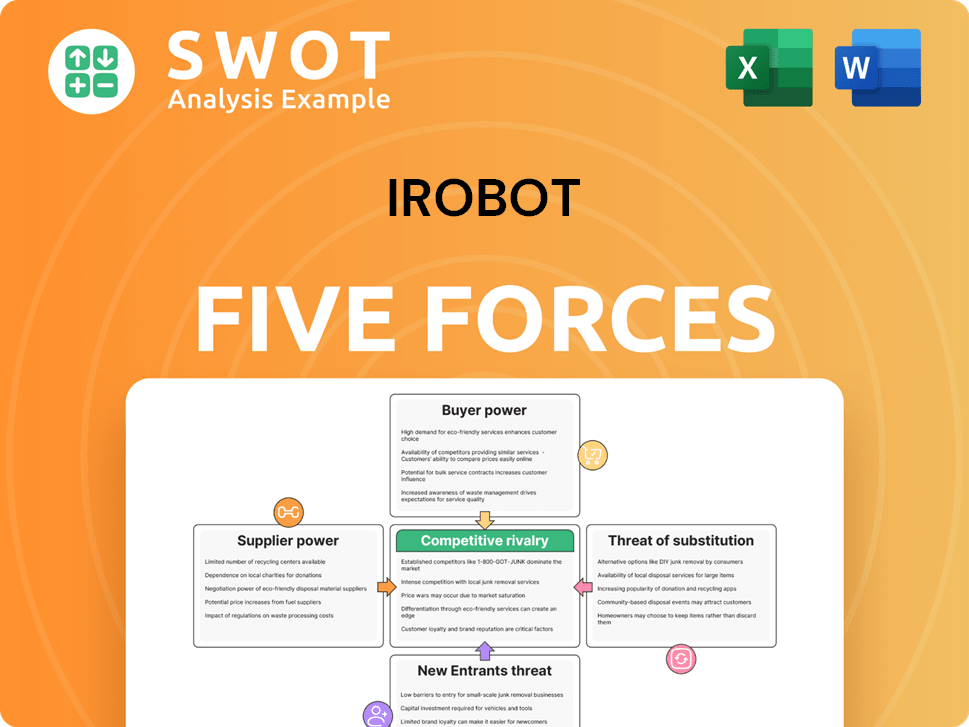
Related Blogs
- What are Mission Vision & Core Values of iRobot Company?
- What is Competitive Landscape of iRobot Company?
- What is Growth Strategy and Future Prospects of iRobot Company?
- How Does iRobot Company Work?
- What is Sales and Marketing Strategy of iRobot Company?
- What is Brief History of iRobot Company?
- Who Owns iRobot Company?
Disclaimer
All information, articles, and product details provided on this website are for general informational and educational purposes only. We do not claim any ownership over, nor do we intend to infringe upon, any trademarks, copyrights, logos, brand names, or other intellectual property mentioned or depicted on this site. Such intellectual property remains the property of its respective owners, and any references here are made solely for identification or informational purposes, without implying any affiliation, endorsement, or partnership.
We make no representations or warranties, express or implied, regarding the accuracy, completeness, or suitability of any content or products presented. Nothing on this website should be construed as legal, tax, investment, financial, medical, or other professional advice. In addition, no part of this site—including articles or product references—constitutes a solicitation, recommendation, endorsement, advertisement, or offer to buy or sell any securities, franchises, or other financial instruments, particularly in jurisdictions where such activity would be unlawful.
All content is of a general nature and may not address the specific circumstances of any individual or entity. It is not a substitute for professional advice or services. Any actions you take based on the information provided here are strictly at your own risk. You accept full responsibility for any decisions or outcomes arising from your use of this website and agree to release us from any liability in connection with your use of, or reliance upon, the content or products found herein.